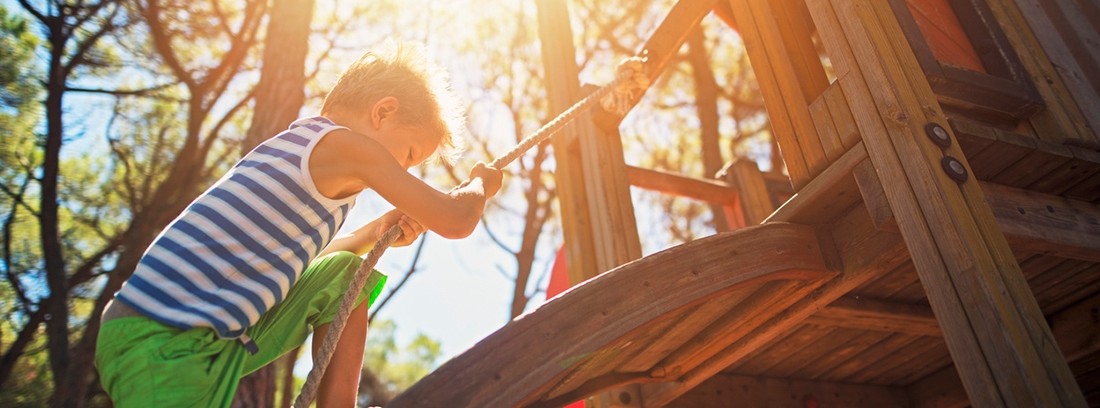The best exercise for children

It seems that today, according to some studies, children spend 600 kcal / day less with activity than 50 years ago. Today's conveniences and technological advancements are largely responsible for this change. And it is in the hands of parents and educators to reverse this situation.
Benefits of exercise for children
The virtues that it has in it could be divided into four levels:
Physical
The development of the cardiorespiratory system, skeletal muscle and the maturity of the nervous system. Maximum bone mass is reached between 20-30 years, so the activities that help its development should be focused before that age. In this way, mineralization is improved and the future risk of osteoporosis is reduced. The existence of cardiovascular diseases and their complications are rare at these ages if we compare them with adulthood. Physically active children have a lower risk of suffering from hypertension, diabetes, overweight, obesity, or alterations in triglycerides and cholesterol levels.
Mental
It has been shown after various studies that exercise helps reduce some emotional and psychological disorders. Nightmares, fears and anxiety can improve if physical activity is included in the child's daily routine. In addition, a increase in school performance since in parallel they grow in self-esteem and confidence. Another aspect is that they become aware of their body perception. It undergoes many rapid changes in a short time, which is difficult for them to accept.
Social
They learn to live with more children and can see the differences and similarities that exist between them. They assimilate that what happens to them not only happens to them but that there are also more children who are in the same situation. At first it helps them to share but at the same time they develop as autonomous subjects. An important part is the. Especially at the beginning and to stimulate them, you have to look for activities where the child feels wrapped up. As much as possible you have to get involved in the practice and share it with them. It will give them security and they will feel part of the family, because it has an inclusive character.
Behavioral
If you acquire good habits in the present, you will enjoy better health in the future, in addition to having these routines incorporated into your day-to-day life. There are studies that show that obese children in childhood are at higher risk of being obese in adulthood. In addition, the factors associated with obesity such as the increase in complications (HT, diabetes ...) increase in adulthood. If walking to school or climbing stairs is included in the daily routine, it will be easier than when the child is more autonomous, continue with the same habits.
Thus, we must not stop trying to make exercise part of the child's day-to-day life.
How to choose the most suitable activity?
It is important to take into account several considerations, but it could be said that the base would be choose an activity that is fun for the child. It's about having a good time, feeling competent, experiencing a variety of action and movement, and not being imposed or forced. In the latter case, apathy usually appears and the creature stops enjoying itself. In addition, it is easier for him to injure himself since he does not pay the attention that he should.
Each one presents its characteristics both physically, mentally and in the environment, so it is necessary to adapt. Regarding the environment, it is not the same to live in the country, in the city, in an apartment or in a house. The customs of the country, society or family are also factors present when defining themselves by the type of activity.
Be that as it may, today the. There are sports clubs where yoga classes for children, swimming courses and other disciplines are offered from very early ages. And if by geographical location we can enjoy winter sports, skiing, skating or simply sledding, they are already a perfect start.
On a personal level, it is about the activity that is carried out helping to improve those qualities that are less developed in the child and to enhance those that are more so.
Matter of combining
In general, it is about combining aerobic activities with those that help build muscle and bones. In the latter case, in addition to a good diet that includes dairy products, specific activities must be added. It is known that the deposit of calcium in the bones needs the “impact”. That is to say, pressure on joints and bones, which occurs in activities such as basketball, tennis, dance ... For this reason it is necessary to combine activities in the water with others in "dry".
Recommendations by age groups
- 2-5 years: basic movements, it is best to let them play freely. Some recommended sports would be running,, cycling and performing.
- 6-7 years: coordination is involved and team games can now be introduced. Swimming, tennis, soccer, basketball, gymnastics, or martial arts are recommended.
- From 8 years old: you can do any type of sport wearing the appropriate protection and being aware of the limitations of each child. You can begin to gradually introduce the exercise to gain strength.
Remember that with it, you have a 24-hour Pediatric Guidance Service where you can make all inquiries related to the health of your children.
- How much: moderate to intense physical activity, a minimum of one hour a day.
- Many benefits: physically, mentally, socially and behaviorally for the little ones.
- The best: choose a fun activity for the child, neither imposed nor forced.
Sports Medicine Specialist
(Updated at Apr 14 / 2024)